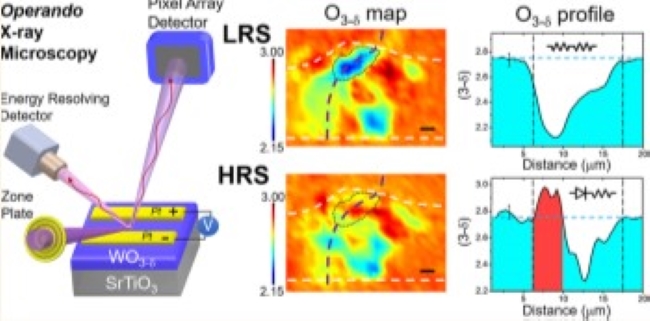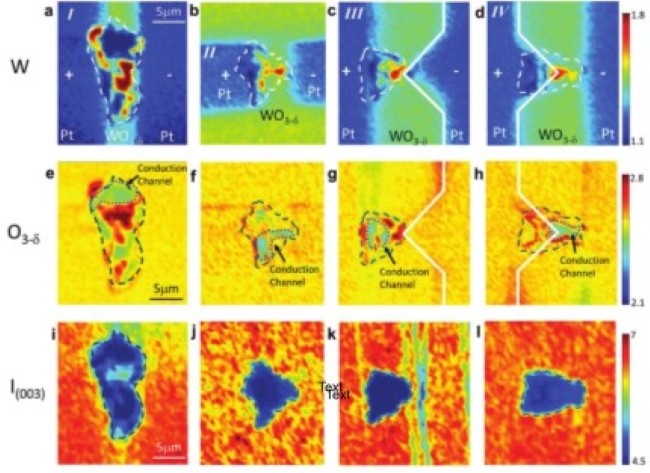Neuromorphic computing and memristive devices suffer from poor understanding of the physical processes governing their behaviors. Using operando X-ray microscopy at the Advanced Photon Source, we showed both the existence of threshold behavior involving oxygen defects and the controlled formation of conduction channels in model WO3-d-based devices.
Memristive (resistive switching) devices are an emerging technology that enables investigations of rich interdisciplinary science and novel device functionalities, such as nonvolatile memories and nanoionics-based synaptic electronics. Recent work has shown that the reproducibility and variability of the devices depend sensitively on the defect structures created during electroforming, as well as their continued evolution under dynamic electric fields. However, a fundamental principle guiding the material design of defect structures is still lacking due to the difficulty in understanding dynamic defect behavior under different resistance states. We demonstrated the existence of threshold behavior by studying model single-crystal devices: resistive switching requires that the pristine oxygen vacancy concentration reside near a critical value [1]. This work provides a general strategy for designing functional defect structures around threshold concentrations to create dynamic, field-controlled phases for memristive devices.
Neuromorphic computing provides a means for achieving faster and more energy-efficient computations than conventional digital computers for artificial intelligence (AI). However, its current accuracy is generally less than the dominant software-based AI. The key to improving accuracy is to reduce the intrinsic randomness of memristive devices, emulating synapses in the brain for neuromorphic computing. Using a planar device as a model system, we demonstrated the controlled formation of conduction channels with high oxygen vacancy concentrations by designing sharp protrusions in the electrode gap, as observed by X-ray multimodal imaging of both oxygen stoichiometry and crystallinity [2]. This work demonstrates an effective route to control the otherwise random electroforming process by electrode design, facilitating the development of more accurate memristive devices for neuromorphic computing.
- H. Liu, Y. Dong, M. J. Cherukara, K. Sasikumar, B. Narayanan, Z. Cai, B. Lai, L. Stan, S. Hong, M. K. Y. Chan, S. K. R. S. Sankaranarayanan, H. Zhou, and D. D. Fong, Quantitative Observation of Threshold Defect Behavior in Memristive Devices with Operando X-ray Microscopy, ACS Nano 12, 4938 (2018).
- H. Liu, Y. Dong, M. Galib, Z. Cai, L. Stan, L. Zhang, A. Suwardi, J. Wu, J. Cao, C. K. I. Tan, S. K. R. S. Sankaranarayanan, B. Narayanan, H. Zhou, and D. D. Fong, Controlled Formation of Conduction Channels in Memristive Devices Observed by X-ray Multimodal Imaging, Adv. Mater. 2203209 (2022).

